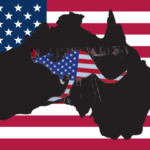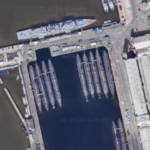Australia’s Role in the Coming US-Stoked World War is Ever-Increasing

US Republican congressman Michael McCaul was recently here spruiking the benefits of the inroads his nation is making onto this continent, which consists of, as our defence minister Richard Marles recently put it, US “force posture now in… every domain: land, sea, air, cyber and space”.
What Marles means by force posture is that the presence that Washington has in this country enables it to wage war from Australia, and this is in terms of “land, sea, air, cyber and space”, and as well, US forces are becoming increasingly interoperable with Australian Defence Forces.
Launched by then Australian PM Scott Morrison in September 2021, the AUKUS security alliance, which involves this country, the US and the UK, has escalated US force posture on this continent, but it has also increased the prominence of Australia as a military force on the global stage.
Indeed, over the time that AUKUS has been in effect, the developments regarding the trilateral alliance increasingly involve discussion of Australian integration into US systems, while any United Kingdom involvement has faded to the periphery, at least as far as this country is concerned.
And further developments over recent days, yet again, reveal that not only has Australia’s strategic position to China made this nation more important to White House strategising, but it would also appear that our ability to hold a noticeable forward role as a co-combatant is favoured as well.
Genocide maintenance
The Houthis, a militant political group from Yemen, commenced military attacks last November upon ships crossing through the Bab-el-Mandeb strait, which is the waterway permitting entrance into the Red Sea for boats carrying goods bound for Israel and these assaults have continued ever since.
The US then determined to push back against the Yemeni Houthis who were attempting to stop the genocide that Israel commenced against the Palestinians in Gaza early last October, which too continues to this day.
And on the mid-December day before passing a bill that facilitated AUKUS Pillar I, the US called on Australia to send a warship to the Red Sea in response to the Houthis, due to their disrupting supply lines toward an apartheid nation that was in the midst of committing genocide on a grand scale.
In a rare display of anything but obedience and sycophancy, our defence minister declined to send a military ship but rather sent what became a total of eleven Australian military personnel, who joined Operation Prosperity Guardian, which comprises a coalition of twenty nations to guard the strait.
And our nation then learnt via US president Joe Biden that it had been involved in a January attack upon the Houthis by the US and Britain, which further, saw support from Canada, Bahrain and the Netherlands, along with this country, which Marles confirmed meant personnel at headquarters.
Mayday genocide disruption
But nine months on and the Houthi disruptions in the strait continue. Just this week, the group blew up a 150,000 tonne Greek oil tanker, after a French ship had rescued the crew, highlighting that the guardians of prosperity perhaps aren’t having the most successful of missions.
This should all come to an end soon, however, as from October onwards for the period of six months, Australia will be taking control of Combined Task Force 153 (CTF 153), which is the transnational naval force maintaining Operation Prosperity Guardian.
“The six-month appointment demonstrates Australia’s ongoing commitment to maritime security and international rules and norms,” explains Defence in a 23 August statement, adding that CTF 153 was established in April 2022, with a focus on the Red Sea, Bab al-Mandeb and Gulf of Aden.
Australia has been involved in conducting transnational maritime security operations in the Middle East, since it launched Operation Manitou in 1990. And since 2002, it’s been a part of the Combined Martime Forces (CMF), with this nation having previously commanded CTFs 150 and 152.
“Assuming the leadership of CTF 153 will see Australia maintain its current contribution to the CMF, which was bolstered in December 2023 in response to Houthi attacks on shipping and maritime traffic in the Red Sea,” Australian Government Defence sets out.
“Operation Manitou and Australia’s command of CTF 153 is separate to the support Australia is providing to international efforts to target and degrade Houthi capabilities in Yemen, under Operation Hydranth,” it adds.
And as for Operation Hydranth, this comprises of seven support personnel assisting with US and UK “defensive actions” to “degrade the Houthis’ threat to the safety of seafarers of all nations, navigational rights and freedoms, international trade and maritime security in the Red Sea”.
But is it nuclear armed?
Meanwhile, on the China front, the Nautilus Institute put out a guide on Monday, explaining how to identify whether US B-52 bombers are nuclear-capable ones or not. And, of course, the reason for this is the US will soon be running B-52s out of the Top End of Australia as part of its force posture.
The Abbott government-signed 2014 Force Posture Agreement provides the US with unimpeded access to dozens of local facilities and areas and when one of these bases, which is on an undisclosed list, is upgraded by the US, the Pentagon takes full control of it.
The Gillard government signed off on the force posture agreements with the Obama administration in 2011, due to its “pivot to Asia”, and these further include a rotation of about 2,500 US marines stationed in Darwin, as well as increasing interoperability between our nation’s air forces.
And in late 2022, it came to light that the US was upgrading RAAF Base Tindall in the Northern Territory, and this revamp would include storage hangars for six nuclear capable B-52 bombers, which the US will be stationing there pointed directly at China.
The Nautilus Institute report warns that the stationing of B-52s locally signals a new development in “nuclear posture for Australia”, which expands on already existing communications assistance out of facilities like Pine Gap to the potential for “direct ADF participation” in actual nuclear strikes.
Report authors Vince Scappatura and Richard Tanter note that of the 76 B-52 bombers that the US currently has active, 46 of them can actually deliver nuclear weapons, whereas the other 30 have been converted to conventional-only bombers, as part of a 2011 treaty with Russia.
The reason why an Australian spotting a B-52 overhead might want to check with the guide and not with their local member as to its capability is that our government respects the US policy of warhead ambiguity, which means we don’t ask if their vessels stationed here are carrying nukes or not.
So, one might ask, how much benefit is this encroaching US presence on local soil, as well as our increasing integration into the US war machine, of to the grassroots people of the nation?
And according to congressman McCaul, what that would be is the US presence has a deterrent effect upon the Chinese, whilst our integration into the US military machine is putting us in good stead for the coming world war against China, Russia and Iran.







